|
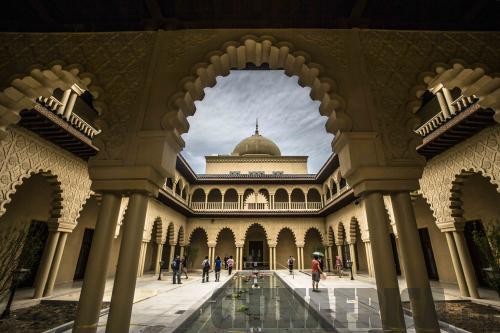 |
|
Arabian Garden (WANG XIANG) |
Benefiting locals
"In fact, from the moment we started constructing the expo in 2009, we wanted to make it a model of environmental improvement and ecological restoration," said Duan.
Since 1997, the China International Garden Expo, which is held every second year, has been held in eight other cities in China. These expos were all held in places that originally had a good ecological environment. When Beijing was given the opportunity, it proposed two places to hold the expo: One was a hilly area with good ecological environment in western Fengtai District. Covered with thick vegetation, technically, this was the best place to hold a garden expo. The other option was the landfill near Yongding River, which was ultimately selected.
"The major reason is that doing so would help restore the ecological environment in the entire area near the Yongding River and also benefit local people. This work is one of the greatest innovations in the history of the China International Garden Expo," said Deng Naiping, Director of the Organizing Committee Office of the Ninth China (Beijing) International Garden Expo.
The Beijing Garden Expo covers an area of 513 hectares, including 267 hectares of land and 246 hectares of water. It consists of 47 gardens constructed by 69 Chinese cities and 34 international gardens built by 37 cities and organizations from 29 countries, including pavilions from African countries, such as the Sudanese, Ethiopian, Cameroonian and Egyptian pavilions.
"Thanks to the designers and constructors, the former landfill is now a beautiful landscape along the Yongding," said Deng during his address at the expo's opening ceremony on May 18.
Regarded as the mother river of Beijing, the Yongding River and its surrounding area has benefited enormously from the Beijing Garden Expo, particularly in terms of ecological restoration.
"Sustainable social and economic development in Beijing, especially in Fengtai District, cannot be achieved without a good ecological environment. Restoration of the ecological environment along the Yongding River benefits local people as the project can purify water and air, protect biodiversity and boost tourism and service industries," said Li.
|
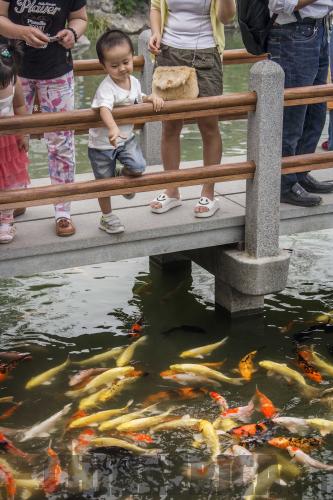
|
|
A toddler feeds goldfish from a footbridge in the Hangzhou Garden of Beijing Garden Expo on June 1, Children's Day WANG XIANG |
Sci-tech power
According to a China Association for Science and Technology press conference in early June, science and technology play an important role at the expo.
"Actually, science and technology have helped us greatly in planning the expo," said Duan. One of the problems is that the expo will run from May to November, but some of the flowers in the gardens do not blossom during this period. To solve the problem, scientists have taken a variety of measures to ensure that visitors will see lush gardens no matter when they attend the expo. These measures include things such as freezing peony seeds to delay the flowers' blooming period, which normally occurs in April, to May, June and even July; they have also changed the growing light and temperature environment of some chrysanthemums so that they can bloom in September.
To overcome problems caused by the shortage of water in Beijing, scientists designed an innovative rainwater collection system for the expo.
"This system can collect the rain that falls in the park to irrigate the landscape," said Liu Xueyan, an engineer at the Beijing Institute of Water.
Rainwater is filtered through collection tanks embedded inside the landscapes and permeable materials on the paths and squares inside the expo, before it goes to an underground reservoir. The water can then be used to irrigate expo plants.
Solar photovoltaic power generation technology has also been widely applied on the expo roofs. According to Guo Xinghai, General Manager of Beijing Greenery Energy Co. Ltd., advancements made in solar photovoltaic power generation technology in China allow such technology to be widely used. This photovoltaic power is mainly used for lighting buildings, road lamps and in low-voltage current systems.
To recharge the electric vehicles that carry passengers around the expo, a wind-solar hybrid system was also built. Each wind-solar hybrid plant has a wind turbine and a solar photovoltaic panel, which can utilize both wind and solar resources to ensure stable power generation. Conservative estimates show that this system will generate at least 15,000 kwh of electricity during the six-month expo period.
"This expo was constructed on a deserted area and should be environmentally friendly. By using environment-friendly technologies, we have totally changed the ecological environment here," said Zhang.
Expo Fast Facts
» Area: 513 hectares, including 267 hectares of land area and 246 hectares of water area
» 35,000 tourists visited daily in the first 15 days
» 15,000 kwh of electricity will be generated by the wind-solar system
» 34 international gardens on expo grounds, including pavilions from Cameroon, Egypt, Ethiopia and Sudan
Email us at: niyanshuo@chinafrica.cn
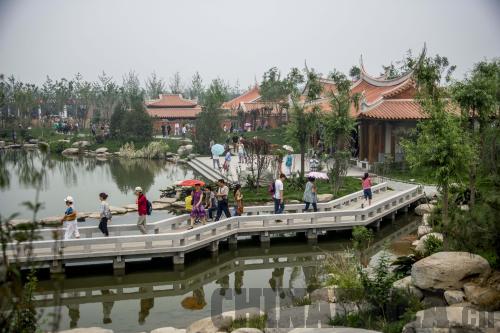 |
|
Lingnan Garden WANG XIANG |
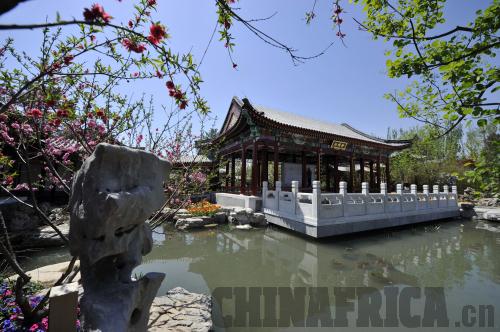 |
|
Beijing Garden WANG XIANG |
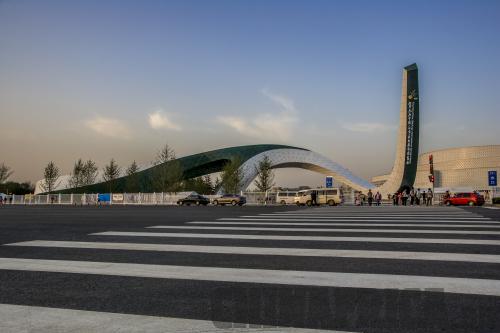 |
|
A new highway vastly improves traffic conditions at the gate of the Beijing Garden Expo (WANG XIANG) |
|
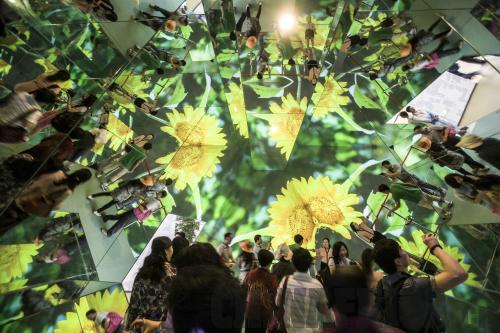
|
|
A mirrored corridor enchants visitors to the main pavilion of the Beijing Garden Expo on May 18 (WANG XIANG) |
|